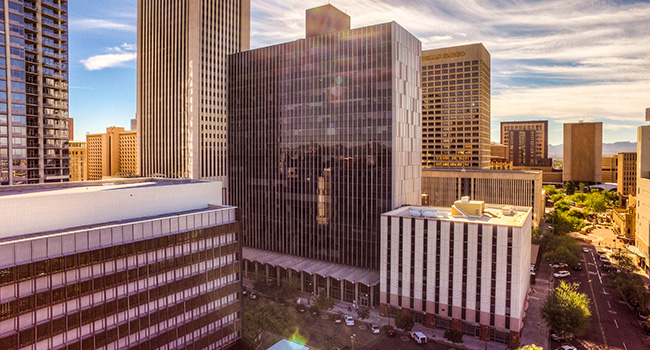It’s that time of year again when commercial real estate firms analyze market activity based on numbers and reports from the first two quarters of the year, and predict how that will impact the rest of 2016 through next year.
Experts in their respective markets weighed in on the findings from quarter two reports in this mid-year market update of Greater Phoenix. Overall, the commercial real estate market appears to be steadily progressing in the right direction but not all markets are seeing equal levels of activity.
Retail
- Trends: Vacancy down, rent rates up, net absorption down
- Key Stat: Retail vacancy in the greater Phoenix metro is 60 basis points lower than one year ago
- Outlook: Despite some setbacks, the market is still trending upward at a modest rate, and looks to continue this trend throughout the rest of the year
With vacancy trending downward and rents rising, the Phoenix retail market is showing very measured and steady improvement. However, notable closures of large retailers such as Sports Authority and Carl’s Jr. have served as setbacks and affect the market’s overall net absorption numbers.
Larry Miller, associate vice president specializing in retail leasing at Colliers International, believes that despite the dip in net absorption from these closures, he still views the market as strong.
“We’re still moving forward to an extent,’ he says. “The big key for the second half of the year will be how we’re affected by the Sports Authority closures and the like.”
Despite these closures, the market numbers are improving in small increments. According to Colliers’ mid-year retail market report, average asking rent has risen by 3.3-percent over the last year. Vacancy has dipped as low as 9.4%. Total sales activity over the first half of the year is up 36% from the first half of last year.
Miller believes this momentum will continue into the second half of the year, where retail expansion is typically stronger.
Industrial
- Trends: Vacancy flat, rent rates up, net absorption down
- Key stat: Net absorption in Q2 is down for the first time in 12 quarters
- Outlook: The market is in recovery, but looks to improve with a strengthening housing market on the horizon
Sales and leasing activity of industrial buildings have both been accelerating over the first half of the year, but the market is still very much in recovery, according to Rob Martensen, senior vice president at Colliers.
Net absorption in the industrial market is down to 865,000 square feet in Q2, down from 1.7 million square feet in the first three months of the year. Martensen attributes this drop to the increase in industrial buildings over the first half of the year.
“The net absorption number is not as good as it should be, just because there’s a lot of new construction,” he says. “If new construction slows down, which I think it will, and leasing continues, then we’ll start to absorb more space.” The Colliers mid-year report projects net absorption to reach 6.7 million square feet by the end of the year.
Martensen projects that the market will continue to show steady improvement with the rise of the housing market. “We’re recovering without housing, and industrial is always real dependent on housing. If and when housing comes back, I think [industrial] will really get going,” he adds.
Multifamily
- Trends: Vacancy up, rent rates up, transaction activity up
- Key stat: Rents have risen over 8% over the course of the last 12 months
- Outlook: More improvement in the multifamily market with vacancies tightening and rents continuing to shoot upward
For the multifamily market, the second quarter was almost all positive. With rents already steadily rising, Q2 continued showing strength, and the improvement is not projected to wane anytime soon.
While vacancy rose to 5.9-percent, a typical uptick for the summers in Phoenix, investment activity saw a peak it hasn’t seen since 2007, with more properties being exchanged this quarter than any quarter since that year.
Cliff David, vice president of investments at Marcus and Millichap, attributes this historic peak in sales activity to the changing trends of the younger consumers. “That younger cohort historically, before this cycle, was buying homes,’ he says. “Now we’re seeing more of those folks rent, especially multifamily.”
David says he feels the market now is more likely to be sustainable than when it peaked in 2007, due to Phoenix’s desirability as an affordable market.
“Phoenix is a better value than some of the other major markets we compete with for capital,” he explains. “So you couple our strong fundamentals, the favorable corporate tax structure that we offer as a state, and the value to buy apartments here relative to other major metros in the west, Phoenix has a really good story.”
Medical
- Trends: Vacancy down, rent rates up, net absorption up
- Key stat: Vacancy has dropped 180 basis points over the last year
- Outlook: expectations for tenant demand to rise to its highest since a decade ago
The first half of 2016 has seen a very sharp decrease in vacancy in medical offices in the Greater Phoenix area, with increases to asking rents and tenant demand. Vacancy at the end of the second quarter was resting at 16-percent, down 180 basis points since Q2 of 2015. Additionally, asking rents have risen a modest 2.5-percent, indicating the medical market is beginning to trend in the right direction.
Michael Dupuy, vice president at Colliers, partly credits the changing attitudes of physicians toward new healthcare structures for the encouraging trends in rent rates and vacancy.
“I think physicians are more comfortable with their business models and compensation structures than they were after the healthcare reform,” he says. “I am optimistic we’ll see physicians and healthcare users continue to explore reasons why they should grow as opposed to why they should contract.”
Both Dupuy predicts that now that there is this attitudinal shift among physicians, the market will see much more of a smoother recovery into the rest of 2016, expecting the tenant demand to rise to its highest since nearly a decade ago.
Office
- Trends: Vacancy up, rent rates up, net absorption up
- Key stat: Net absorption totals have surpassed 4.7 million square feet over the last 12 months
- Outlook: the market is expected to remain healthy as job growth continues to rise
Ryan Timpani, vice president at Colliers specializing in office leasing and sales, called Q2 of 2016 “one of the strongest quarters we’ve had in the last few years.”
The numbers seem to support this claim: net absorption is seeing its strongest 12-month period since 2007, vacancy has dipped to 16.6-percent from 18.1-percent at Q2 2015, and rental rates have risen 5.5-percent over the past year as well.
Healthy job growth in the Greater Phoenix area is largely responsible for this hugely successful quarter, according to Timpani. He says the numbers are a result the influx of companies relocating to Phoenix, as well as a surge of brand new companies.
“We continue to see both existing companies hire and save more space in addition to some corporate relocations from out of market,” he explains. “So many new companies have rather quick occupancy dates, so they don’t have the benefit of waiting for new construction, so they’re gobbling up existing inventory.”
This success is projected to last through the rest of 2016 and potentially onward. “Everyone seems to think that the fundamentals are strong enough for this momentum to carry well into 2017,” Timpani adds. “Employers are still feeling relatively confident of the state of the economy right now, and can continue to hire and add more jobs.”






